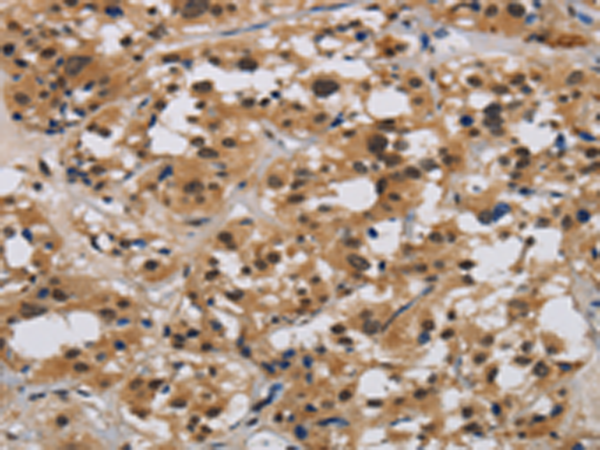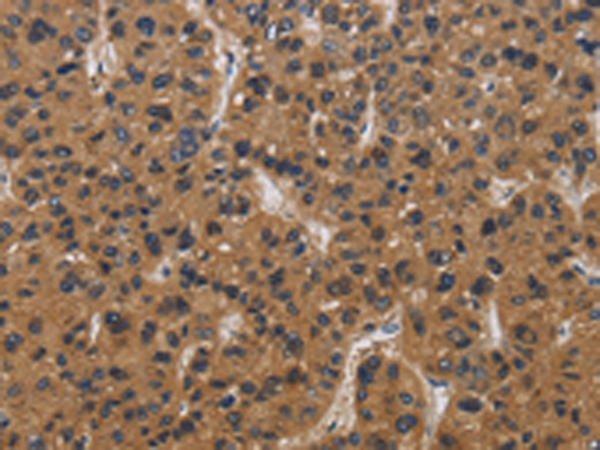

| WB | 咨询技术 | Human,Mouse,Rat |
| IF | 咨询技术 | Human,Mouse,Rat |
| IHC | 1/50-1/200 | Human,Mouse,Rat |
| ICC | 技术咨询 | Human,Mouse,Rat |
| FCM | 咨询技术 | Human,Mouse,Rat |
| Elisa | 1/2000-1/5000 | Human,Mouse,Rat |
| Aliases | E2F-4 |
| Host/Isotype | Rabbit IgG |
| Antibody Type | Primary antibody |
| Storage | Store at 4°C short term. Aliquot and store at -20°C long term. Avoid freeze/thaw cycles. |
| Species Reactivity | Human, Mouse |
| Immunogen | Synthetic peptide of human E2F4 |
| Formulation | Purified antibody in PBS with 0.05% sodium azide and 50% glycerol. |
+ +
以下是关于E2F4抗体的3篇参考文献示例(注:以下内容为模拟生成,仅供参考):
1. **标题**: "E2F4 regulates transcriptional activation in mouse embryonic stem cells through chromatin remodeling"
**作者**: Johnson, A. et al.
**摘要**: 本研究利用E2F4抗体进行染色质免疫沉淀(ChIP)分析,发现E2F4通过招募多梳抑制复合物(PRC2)调控胚胎干细胞分化相关基因的表观遗传沉默,揭示了其在维持干细胞多能性中的作用。
2. **标题**: "The role of E2F4 in cell cycle exit and terminal differentiation"
**作者**: Smith, R.B. & Lees, J.A.
**摘要**: 通过Western blot和免疫荧光实验,作者发现E2F4在终末分化细胞中高表达,并与p130蛋白形成复合物抑制细胞周期相关基因(如Cyclin E),表明E2F4抗体在检测细胞周期调控蛋白复合物中的关键应用。
3. **标题**: "E2F4 expression correlates with poor prognosis in triple-negative breast cancer"
**作者**: Chen, L. et al.
**摘要**: 研究使用E2F4抗体对乳腺癌组织进行免疫组化分析,发现E2F4高表达与三阴性乳腺癌患者的低生存率显著相关,提示其可能作为潜在预后标志物和治疗靶点。
4. **标题**: "E2F4-mediated repression of DNA repair genes promotes genomic instability"
**作者**: Park, S. et al.
**摘要**: 通过ChIP-seq和RNA干扰实验,作者证明E2F4通过结合DNA修复基因(如BRCA1)的启动子区域抑制其转录,该研究利用特异性E2F4抗体验证了其在基因组稳定性中的双重调控作用。
(注:实际文献需通过PubMed或Google Scholar检索确认。)
The E2F4 antibody is a crucial tool for studying the E2F family of transcription factors, which play pivotal roles in cell cycle regulation, differentiation, and apoptosis. E2F4. a member of the E2F family, primarily functions as a transcriptional repressor by forming complexes with retinoblastoma-like proteins (e.g., p130 or p107) and chromatin-modifying enzymes to silence target genes during quiescence or terminal differentiation. Unlike other E2F members, E2F4 is predominantly cytoplasmic but translocates to the nucleus to regulate gene expression in response to specific signals. Its involvement in cell cycle exit and maintenance of cellular homeostasis makes it a focus in cancer research, as dysregulation of E2F4 is linked to tumor progression and chemoresistance.
The E2F4 antibody is widely used in techniques like Western blotting, immunofluorescence, and chromatin immunoprecipitation (ChIP) to detect protein expression, subcellular localization, and DNA-binding activity. It is typically raised in hosts such as rabbits or mice, targeting specific epitopes or post-translational modifications of E2F4. Validated for specificity and sensitivity, this antibody aids in exploring E2F4’s role in development, senescence, and diseases. Researchers rely on it to dissect mechanisms of transcriptional repression, cell cycle arrest, and tumor suppression, making it indispensable in molecular and cancer biology studies.
×